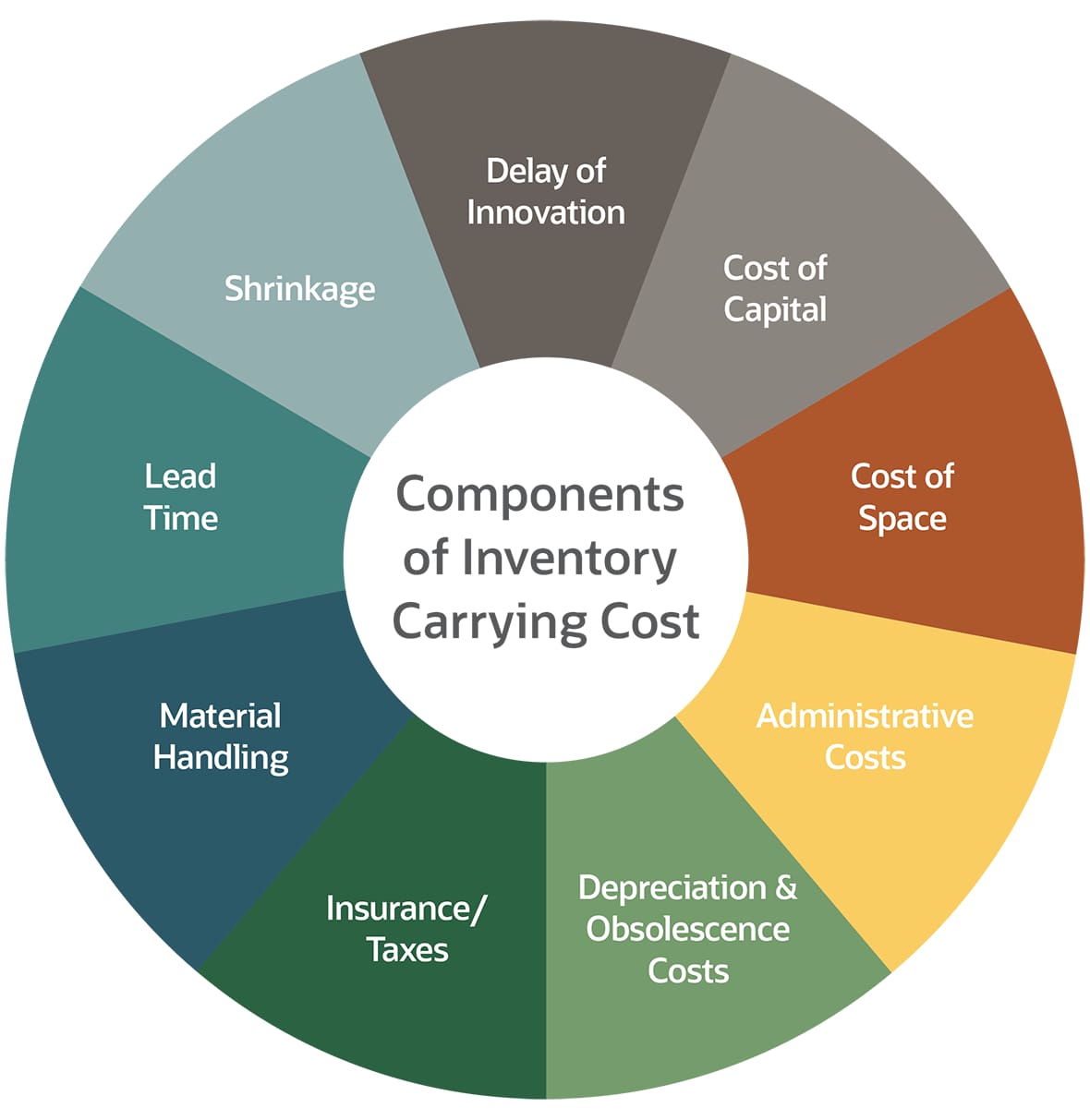Business leaders tend to be laser-focused on revenue growth, and understandably so. But that fixation may mean they overlook less-obvious costs—even as stealthy expenses dent profitability. Among the priciest under-the-radar outlays are inventory carrying costs, the expenses that come with holding inventory until it’s sold.
Are you losing money this way? Ask: Do we pay every month to store lots of unsold goods? Are we sometimes short on working capital? Have we had to mark down items because they sat too long in a warehouse?
If so, you may need to adopt some new strategies to keep stock moving.
What Are Inventory Carrying Costs?
Carrying costs are among the top inventory management challenges companies deal with. These expenses arise from keeping products shelved at a warehouse, distribution center or store and include storage, labor, transportation, handling, insurance, taxes, item replacement, shrinkage and depreciation. Opportunity cost—the investment possibilities a company must decline because its resources are tied up in inventory—is also a factor.
Typical holding costs, another name for inventory carrying costs, vary by industry and business size and often comprise 20% to 30% of total inventory value, and it increases the longer you store an item before selling it. The percentage will vary based on the number of items a business sells, its inventory turnover ratio, the location of its warehouse or store and its storage requirements.
Key Takeaways
- Inventory carrying costs—the full amount businesses spend to stock and store items before they’re sold—can have a significant impact on profitability.
- This expense often totals about one quarter of the inventory’s total value. For a more precise calculation, add up your carrying costs and divide that number by the total inventory value.
- Excessive safety stock, slow-moving inventory, inadequate tools for inventory management and planning, poor forecasting and flawed inventory/order management processes can all cause holding costs to soar.
- To reduce inventory carrying costs, keep less inventory on hand, purchase a capable warehouse management system, explore ways to increase inventory turn and evaluate the effectiveness of your warehouse layouts.
Inventory Carrying Costs Explained
Inventory carrying costs are a crucial metric that helps determine whether you’re running an efficient operation. High carrying costs could mean your organization has more inventory on hand than it needs based on demand, that you need to adjust the frequency with which you place orders with manufacturers or distributors or that you could do better at keeping stock moving.
Inventory carrying costs can be sorted into four categories: capital costs, storage costs, service costs and inventory risk costs.
Capital expenditures are monies spent on products and any interest and fees incurred if the company took out a loan to pay for the goods. Storage costs can be fixed, like a mortgage for a store/warehouse, or variable, as are labor, utility and administrative expenses. Taxes, insurance and inventory management software are all examples of service costs.
Inventory risk includes shrinkage, depreciation and product obsolescence.
Why Is Calculating the Cost of Carrying Inventory Important?
Because holding costs may make up one quarter of all inventory spend, they can affect a business’ overall financial health. If an organization can’t quantify the cost of keeping stock on hand, such as by employing an inventory or stock control system, it may end up with cash flow problems.
A company could also miss out on a promising investment or growth opportunity because it has too much money tied up in inventory—all without leaders even realizing how much carrying costs are holding back the business.
Here are other reasons holding costs matter:
Production planning: Once a company understands how much it spends to store inventory, it may rethink its production schedule. In particular, if a certain product can be manufactured quickly, the business may want to keep only a small quantity in stock. On the other hand, a certain item may be a big seller and have a low carrying cost, so it makes sense to dedicate more warehouse space to it. A material requirements planning (MRP) process can provide insights.
Profitability of existing inventory: By calculating inventory carrying costs and tracking the value of each product, an organization can better estimate how much profit it can expect to earn from existing inventory. Carrying costs are a major inventory expense, so once that’s deducted, it’s easier to measure profit by item.
Inventory accounting: Inventory is one of the biggest expenses for many companies, so it’s important to accurately calculate the cost of holding that inventory, as well as the value of those products. The accounting team needs this data to produce accurate financial statements.

10 Components of Inventory Carrying Cost and How to Reduce Them
Many expenses factor into the inventory carrying costs equation—and together they add up to a very common way that businesses waste money.
Let’s break down each component:
1. Cost of Capital
Cost of capital, usually the biggest portion of inventory carrying costs, includes the purchase price of the products plus any interest and other fees if the business took on debt to pay for that inventory. Tying money up in products could affect cash flow and, consequently, increase the need for and cost of additional capital.
To reduce the cost of capital, invest in forecasting that leads to smaller or more strategic purchases. You could also negotiate a lower purchase price with suppliers.
2. Cost of Storing Inventory
The real estate items take up in a warehouse or store is valuable: Warehouse space costs an average of $6.53 per square foot, so each shelf, bin and box counts. If you use a third-party logistics (3PL) provider, it’s easier to figure out this cost, because that partner may charge by the shelf, pallet or item. A company can often re-imagine its warehouse layout or how it stores products of different shapes/sizes to reduce storage costs. Paring down inventory may even allow a company to move to a smaller warehouse, another way to trim storage costs.
3. Employee Cost
This is simply the cost of labor associated with receiving and putting away products, fulfilling orders and other touchpoints. Businesses can often rearrange their warehouses to increase employee productivity by, for example, storing the most popular items near packing stations or supplementing human workers with automation. Experimenting with different picking methods and using software that maps the most efficient pick paths for employees are worth considering if labor costs are rising.
4. Opportunity Cost
If you overspend on inventory, that ties up money you could have used for marketing, new hires, real estate and countless other investments—many of them more valuable to the organization than items sitting on a shelf.
5. Obsolescence
Obsolete inventory—stock that can no longer be sold because it’s reached the end of its lifecycle—can lead to a spike in inventory carrying costs. Products become obsolete after they depreciate to the point of having no value and must be written-off. Organizations can minimize obsolete inventory by finding ways to offload stock while it still has some value, perhaps through deep discounting, donating it or by selling it to a liquidator. Otherwise, you’ll likely pay to dispose of it.
Without performing regular checks, companies may be holding obsolete inventory in the warehouse that incurs added costs and ties up space in the warehouse; so, it’s important that items are disposed of promptly before they become obsolete.
6. Insurance/Taxes
Many companies invest in an insurance policy to protect one of their most valuable assets: inventory. Then if a flood or fire destroys a store or warehouse, all is not lost. But the more product in the warehouse, the more that insurance policy will cost.
Similarly, the more inventory you hold, the higher your taxes. An organization can pare down both insurance and tax expenses by keeping fewer products or only its highest-performing goods in the warehouse.
7. Administrative Costs
Administrative costs encompass a wide variety of expenses, including property taxes, facility maintenance and cleaning, transportation and equipment depreciation. Generally, if a company holds more inventory, it has higher administrative costs, in part because it needs a larger facility.
8. Material Handling
Labor and the number of “touches” a product requires—from putting it in a warehouse bin to printing a shipping label—is a big part of the money spent on material handling. But machinery, equipment and damage to products after you take possession are also part of this expense category. A company may not need as much machinery or equipment, or it may use them less frequently and reduce the need for maintenance and repair, if it stores fewer items in its facility.
9. Shrinkage
When inventory is lost after your company purchased it but before it’s sold to a customer, that’s shrinkage. Sources of inventory shrinkage include theft, fraud, damage in transit or record-keeping mistakes. As with other inventory carrying costs, the more stock a business holds, the more money it will commonly lose to shrinkage.
An organization could identify and terminate employees who are stealing, talk to vendors about common causes of damaged goods and perform more frequent physical inventory counts to reduce shrinkage.
10. Delayed Innovation
If a company is constantly focused on moving excess stock, it’s likely not innovating and brainstorming ways to, for example, add a feature or new product requested by customers. Businesses can find themselves stuck in this loop if they’re consistently carrying too much inventory. Optimizing stock levels will free up resources for research and development.
Inventory Carrying Cost Formula and Calculation
Companies need to regularly measure their inventory carrying costs to find out if holding costs represent a disproportionate amount of inventory value. This calculation will help businesses determine when they need to reevaluate their processes and practices.
To determine inventory carrying costs, first add up the expenses outlined above—capital, storage, labor, transportation, insurance, taxes, administrative, depreciation, obsolescence, shrinkage—over one year. Then divide those carrying costs by total inventory value and multiply the number by 100 for a percentage.
Inventory Carrying Costs = Cost of Storage / Total Annual Inventory Value x 100
For a quick, rough estimate of carrying costs, divide your total annual inventory value by four.
Carrying Cost Example
As fall winds down, retailer Seasonal Inspirations’ two warehouses are still full of winter clothing. It wants to better understand the price of having so much inventory on its shelves as it tries to make room for spring apparel.
The retailer calculates storage costs of $10,000, labor expenses of $2,000, $3,000 for shipping, $2,000 for insurance and $1,000 for shrinkage and depreciation. That puts total inventory carrying costs at $18,000, and that inventory has a cost of goods of $75,000.
$18,000 / 75,000 x 100 = 24%
Per that calculation, Seasonal Inspirations has inventory carrying costs of 24%.
5 Reasons a Company Holds Inventory
Striking an ideal inventory balance is no simple task. Many companies think it’s better to have too many items than run out and lose a sale and potentially damage a customer relationship. Here are a few other reasons organizations hold onto too much stock, pushing up their carrying costs:
1. Safety Stock
Stocking just enough product to cover expected need can be a risky proposition. That’s why most companies carry some safety stock, or extra inventory to cover unpredictable events like a surge in demand, an unexpected supplier delay or a damaged shipment. It’s generally a good idea to have safety stock for popular items, but be judicious because excess safety stock will lead to unnecessarily high holding costs.
2. Cyclical or Seasonal Demands
Certain businesses—retailers in particular—earn most of their annual revenue in just a few months, making retail inventory management particularly important. An electronics retailer may see a surge in order volume in the months leading up to the winter holidays, while a manufacturer of inflatable pool toys may do most of its business in the spring and early summer. In an effort to be ready for that crucial stretch, these companies may build up large inventory reserves before the busy season starts.
3.Cycle Inventory
After creating sales forecasts, a company purchases cycle inventory. This is the stock required to fulfill anticipated demand for various products; it’s not meant to cover the unexpected, like safety stock. Every products-based business must have cycle inventory, or working stock, to keep up with customer demand and generate sales. Accurate forecasts and cycle counting are crucial to stocking the right amount of cycle inventory.
4. In-transit Inventory
In-transit inventory refers to products a company has purchased but not yet received. Depending on where a supplier is located and the type of product, lead times can be several months, so inventory could be in transit for a long time. Businesses need to account for these goods in transit as they plan future purchasing—yet they can be easy to overlook because they’re not yet in the warehouse. This is especially true if you don’t use an inventory management system that shows the status of all purchase orders.
5. Dead Inventory
“Dead inventory” is another term for obsolete inventory. These are goods a company no longer believes it can sell and that are often written-off as a loss. Dead inventory may linger in a distribution center or the back room, quietly and continually raising inventory carrying costs without leaders even realizing it.
5 Ways Companies Fail to Reduce Carrying Costs
There are a few common causes of unnecessarily high holding costs; any of them can make it difficult for businesses to lower this expense. If your inventory costs seem excessive and you’re not sure why, look into these potential issues:
1. Using Excel and Obsolete Methods
Businesses outgrow spreadsheets quickly because of their limited functionality and lack of automation. With Excel spreadsheets, paper records or other legacy tracking methods, a company’s inventory reports are often inaccurate and can’t update in real time.
And when a business doesn’t know what it already has, it’s much more likely to over-purchase or buy the wrong items. Decisions are guided by feel or best guesses rather than strategy and data.
2. Flawed Demand Forecasting
Poor inventory demand forecasting is a common driver of high holding costs. If a company uses flawed data to create forecasts, it may expect a spike in demand for a certain SKU and load up on inventory, only to see sales fall far short. Or it may falsely assume that because a specific product was a top seller last quarter, that item will continue to fly off the shelves for the next two quarters. In either situation, the company ends up with a lot of excess inventory that’s consuming valuable space and tying up cash that would’ve been better spent elsewhere. See: opportunity cost.
3. Failure to Understand Trends
Accurate inventory and production planning is built on not only accurate data, but people who can effectively analyze and interpret that data. Employees must be able to spot trends in the numbers and interpret the impact. If a purchasing manager fails to realize that sales for several products tapered off for the last month of the third quarter, for example, he might place a big order for the fourth quarter that creates obsolete inventory. Leaders must also account for how industry trends or broader economic shifts could affect demand for its items.
4. Overstuffing and Low Inventory Turnover Ratio
Inventory turnover ratio is a critical metric that shows how often certain products are sold and restocked over one year. This ratio informs purchasing decisions. A low turnover ratio for too many products leaves an organization with high inventory carrying costs and, eventually, obsolete inventory. That creates an overstuffed warehouse packed to the brim with stock that is neither moving quickly nor as valuable as it once was.
5. Flawed Inventory Management/Order Fulfillment Processes
Much like organizations that use Excel or other legacy methods, those without a detailed inventory management strategy will over-order to protect themselves. It’s unavoidable without a solution that lists reorder points based on lead times and current demand and provides real-time visibility down to the SKU level.
Similarly, inefficient fulfillment methods can increase labor costs, while poor warehouse design or storage techniques can raise storage costs and make it easier to overlook existing inventory. That leads to obsolete inventory, depreciation and higher insurance, tax and administration costs.
5 Ways to Reduce Inventory Carrying Costs
There are a number of ways companies can cut inventory carrying costs, and some require minimal time and effort. Smart strategies to spend less money keeping items in stock include:
1. Minimize Inventory On Hand
Although the coronavirus pandemic has laid bare the risks of a just-in-time inventory strategy, companies still often hold too much stock or the wrong products. Start by tracking a slate of inventory key performance indicators (KPIs) that will help you evaluate each SKU to determine if it deserves a place in the store or warehouse, and then help decide the appropriate quantity to keep on hand.
While accurate forecasting is critical, so is software that alerts purchasers when it’s time to reorder and suggests how much to buy. It will take time and experimentation to strike the right balance, but it’s worth it—optimized inventory levels save a lot of money.
2. Speed Up Inventory Turnover Times
Increasing your sell-through rate is another powerful way to lower inventory holding costs, because it means items spend less time on your shelves. Calculate your sell-through rate using this formula:
Sell-through rate = (# of units sold during period / # of units received at start of period) x 100
Review the performance of all products every month to see if they’re selling at the expected rate. If turnover is higher or lower than expected, adjust accordingly. Once again, accurate forecasts will minimize excess inventory that sits around and loses value.
An ability to interpret business- and market-specific trends will also improve your inventory turnover ratio. When companies do find themselves moving through inventory too slowly, promotions and bundling may help clear it out.
3. Redesign Your Warehouse
Businesses often don’t make the most of the space they have. You may be surprised by how dramatically physical changes to a warehouse or store can reduce holding costs. Tweaks could include using containers for more efficient storage, adding shelving to increase vertical space or putting popular items in a central location. All of these methods can drive down labor and storage costs.
Additionally, redesigning a manufacturing plant or warehouse could make it less likely that available inventory goes unnoticed, lowering capital, depreciation, obsolescence, insurance and tax costs.
4. Purchase an Inventory/Warehouse Management System
Technology plays a central role in giving supply chain leaders the inventory visibility they need to make smart decisions. A perpetual inventory system, that is, one that updates in real time, is ideal because it provides a truly real-time picture of inventory levels—not what they were last night or four hours ago. The visibility an inventory management solution offers makes it a much more realistic proposition to strike an ideal balance with stock because it helps employees better time new orders and track metrics like inventory turn and sales volume.
A warehouse management system (WMS) is complementary and can make fulfillment and shipping faster and more cost effective.
5. Renegotiate with Suppliers/Customers
Another method for holding down holding costs is to renegotiate agreements with your suppliers and/or customers. Make sure you’re not bearing the bulk of unavoidable risks and costs before customers buy these items. For example, structure contracts with suppliers so they are responsible for damage, theft or administrative costs while goods are in their possession.
Manufacturers and distributors should explore ways to avoid paying excessive carrying costs. For example, specify a maximum holding time for inventory in the agreement, and tack on fees for each day beyond that period to recoup some of those carrying costs. Retailers should consider doing the same: There’s no reason to take possession of a shipment of meltable Halloween candy in June.
Reducing Inventory Carrying Costs with Inventory Management Software
One powerful step businesses can take to reduce inventory carrying costs is to invest in an inventory management solution. This software offers a multitude of ways to optimize inventory levels, which in turn cuts down on all the expenses outlined above.
The visibility an inventory management system offers is a tremendous asset for any products company, because it empowers purchasing, operations and supply chain professionals to make better decisions. The solution can track not only current stock levels but the status of all outstanding purchase and customer orders.
No more “forgetting” about stock in a shipping container on its way to your warehouse.
This technology will also establish consistent receiving, putaway and fulfillment processes that ensure each item is traceable from the time it enters your warehouse to when the customer receives it. Inventory management software empowers companies to be proactive—they can adjust purchase orders, sales strategies, warehouse layouts and more to address problems early on, before costs pile up.
The reporting tools within an inventory management solution are also invaluable. For example, a business can view its inventory turn or sales numbers for a product category or specific SKU over any period of time. It can monitor the money lost to depreciation or spent on taxes and insurance in a quarter or year.
This data gives decision-makers the insights they need to control inventory carrying costs. A purchasing manager might check the sell-through rate for the last month and decide to cancel an upcoming order for a few products, reallocating that money toward a rush shipment for an item that’s seen sales triple in the last two weeks. This information also helps finance and operations managers build more accurate forecasts.
Leaders should be very selective about the products, and the quantities, they keep in their stores and warehouses. Ultimately, the more strategic an organization can be with the inventory it stores, the lower its holding costs will be.
Bottom line, dodging both out-of-stock and overstock situations is a constant balancing act.
Even with best-in-class forecasting capabilities, it’s almost impossible to get inventory planning exactly right. But an inventory management system that’s tied to a larger ERP platform is a critical step in getting holding costs under control because it enables better forecasting and delivers the real-time visibility every products-based business needs to make intelligent inventory decisions.
Inventory Carrying Costs FAQs
What are examples of carrying costs?
Numerous expenses contribute to inventory carrying costs: The products themselves (capital costs), storage, depreciation, labor, insurance and taxes, obsolete inventory and opportunity cost, along with administrative expenses. That list demonstrates why holding costs can dramatically impact a company’s bottom line.
How do you calculate inventory carrying cost?
Inventory carrying cost is a pretty simple calculation once you’ve figured out all the expenses that go into having these goods on hand. Add all those numbers together for the total carrying costs, then divide it by the total value of the inventory and multiply the result by 100 to get a percentage.









